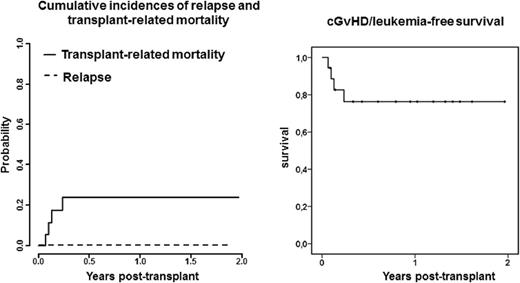Abstract
Allogeneic hematopoietic transplantation is the most powerful therapy for patients with acute leukemia at high risk of relapse. For HLA haploidentical transplantation, we recently applied a protocol consisting of a high-intensity TBI-based conditioning regimen and a peripheral blood CD34+ hematopoietic stem cell graft combined with the adoptive transfer of naturally occurring regulatory T cells (Tregs) and conventional T cells (Tcons). No post-transplant pharmacologic immune suppressive GvHD prophylaxis was given. Such a protocol was associated with remarkably low GvHD and relapse rates (Martelli MF et al., Blood. 124:638-644, 2014; reviewed in Mancusi A et al., Blood 128:2616-2623, 2016).
However, patients who are unfit (because of multiple chemotherapy cycles, previous transplants, infections, or co-morbidities) or elderly are not expected to withstand high-intensity conditioning regimens. For these patients, we developed a reduced-toxicity version based on total marrow and total lymphoid irradiation (TMI/TLI) (Rosenthal J et al., Blood. 2011;117:309-315). TMI/TLI (13.5 Gy and 11.5 Gy respectively) were administered by means of Helical Tomotherapy HI-ART (in 9 fractions delivered two times a day in 4 and a half days). Target volumes were defined as the skeletal bone and major lymph node chains and spleen. In patients with ALL the brain was added as target volume. TMI/TLI was followed by chemotherapy with Thiotepa (2,5mg/kg/day for 2 days), Fludarabine (30 mg/m2/day for 5 days) and Cyclophosphamide (15 mg/kg/day for 2 days). As per our high-intensity protocol, the hematopoietic stem cell graft was foregone by an infusion of 2x10e6/Kg freshly isolated CD4/CD25/FOXP3-positive Tregs and a subsequent infusion of 1x10e6 Tcons. No post-transplant pharmacologic immune suppressive GvHD prophylaxis was given. To date 19 patients with high-risk acute leukemia in remission were enrolled (16 AML, 3 ALL). Median age was 57 years (range: 22-68). All patients engrafted. Four patients developed aGvHD grade ≥ 2. Transplant-related mortality was 21% (2 patients died of infections, 1 of VOD and 1 of aGvHD). Remarkably, no relapse or cGvHD were observed. With a median follow up of 12 months (range: 1-24), 15 of the 19 patients are alive. Thus, leukemia/cGvHD-free survival is 79%. Of course, these data need to be confirmed in a larger cohort of patients and with longer follow up.
In conclusion, the present transplantation protocol was designed to make HLA haploidentical transplantation feasible and effective for unfit or elderly patients with high-risk leukemia. It combines a reduced-toxicity conditioning regimen with safe cellular immunotherapy of leukemia. To date, the clinical results are excellent and extremely encouraging.
No relevant conflicts of interest to declare.
Author notes
Asterisk with author names denotes non-ASH members.


